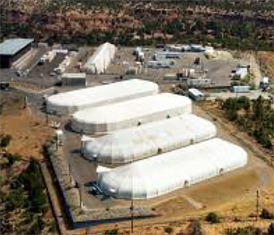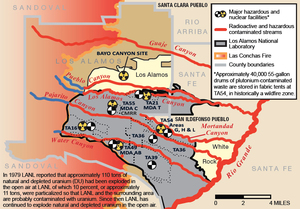During negotiations on the Permit we accepted the addition to WIPP of
Panels 11 & 12
because DOE agreed to
prioritize putting Legacy Waste into these panels
and promised to
prioritize LANL Legacy Waste for Panel 12
(Legacy Waste is old waste created during WWII and the Cold War)
Blue areas are Panels 11 and 12 and the corridors or "drifts"
connecting them, and the new Utility Shaft,
to the rest of the underground repository
On November 4th, DOE submitted their
Legacy Transuranic (TRU) Waste Disposal Plan
as required by the Environment Department’s (NMED)
Hazardous Waste Facility Permit for WIPP.
The Plan as submitted is totally inadequate.
1. DOE’s Legacy Waste Plan defines Legacy Waste so broadly that almost all waste now and in the future could be considered Legacy Waste and be disposed in Panels 11 & 12.
2.The Plan does not include a prioritized schedule for disposal of all the LANL Legacy Waste as required in the Permit.
3. The Plan does not include a provision that DOE must give all generator sites the support they need to prepare Legacy TRU Waste for disposal in WIPP in a timely manner.
4. The Plan makes no mention of another repository and what waste would go into a second repository.
22 sites have been cleaned up of their Legacy Waste—but not LANL.
Dots are TRU waste sites. Black dots are sites that have been cleaned up of Legacy Waste
Consequently, the Stop Forever WIPP Coalition and our supporters are
asking you to request that NMED not approve the Plan
and to
demand that NMED include the following requirements
in the DOE’s Legacy Waste Plan:
• That Legacy Waste be defined as waste generated by 1999 when
WIPP opened.
• To prioritize and designate how all LANL Legacy Waste be
disposed, and
• To ensure that some TRU waste be disposed in another
repository, in another state.
Drums of Legacy Waste waiting to be shipped to WIPP
languish inside a canvas tent at LANL's Area G.
Area G is in a wildfire zone. Wildfires have almost reached
this plutonium waste 4 times in recent years.
TO COMMENT
Please use the above information, the more detailed information below,
or the sample letter at the end of this newsletter to
submit your comments as soon as possible
(the deadline is January 3, 2025 but with the holidays
it’s best to comment early)
Or you can mail them to:
WIPP Information Center
4021 National Parks Highway
Carlsbad, NM 88220
Thanks from your friends at Stop Forever WIPP Coalition
For those who want more details:
1. DOE’s Legacy Waste Plan is saying ANY waste now and in the future can be disposed in panels 11 & 12—this is not appropriate, nor what New Mexico was promised. WIPP was “sold” to New Mexico as a clean-up disposal site for Cold War Legacy Waste—particularly for LANL Legacy Waste. Instead the Plan says it “… must account for the possibility of, and justifications for, accommodating non-legacy waste.”
 Hundreds of drums of waste stretching back to WWII still sit in canvas tents at LANL in the middle of a wildfire zone where fires have almost reached the plutonium waste four times in recent years. If the waste were to burn, the plutonium and hazardous materials would be vaporized and blanket northern New Mexico, making the land permanently uninhabitable, similar to Fukushima, Japan.
Hundreds of drums of waste stretching back to WWII still sit in canvas tents at LANL in the middle of a wildfire zone where fires have almost reached the plutonium waste four times in recent years. If the waste were to burn, the plutonium and hazardous materials would be vaporized and blanket northern New Mexico, making the land permanently uninhabitable, similar to Fukushima, Japan.
Thousands of cubic meters of waste is buried at LANL and threatens the regional aquifer. That waste must be dug up.
DOE needs to finish the clean-up mission it was tasked with for WIPP and move all Legacy Waste off the Pajarito Plateau, put it into containers and safely ship it to WIPP.
To do this, the Plan must include a definition of Legacy TRU Waste that defines waste in specific terms and excludes waste generated after 1999 when WIPP opened.
2. DOE must show good faith by prioritizing all Legacy Waste over non-legacy waste, and in the Plan, must show how they will give all generator sites the support needed to prepare Legacy TRU waste for disposal in WIPP in a timely fashion.
 DOE has shown bad faith in the past and the Stop Forever WIPP Coalition believes that it will not prioritize Legacy waste as required in the permit and will continue to let the Legacy Waste languish, as it has for the past 70 years.
DOE has shown bad faith in the past and the Stop Forever WIPP Coalition believes that it will not prioritize Legacy waste as required in the permit and will continue to let the Legacy Waste languish, as it has for the past 70 years.
DOE wants to dispose non-legacy waste from pit production and “surplus” plutonium in Panels 11 and 12, and we believe it will purposely let the generator sites continue to be slow on preparing their Legacy Waste unless the Plan requires DOE to support the generator sites in accelerating and prioritizing this preparation.
New pit production waste is estimated to be at least 25 percent of the total capacity limit of WIPP. New pit production waste and “surplus” plutonium would be about two-thirds of all of the radioactivity in WIPP.
3. DOE's plan does not even mention a second repository for at least some of the TRU waste that will be generated in the future, even though the Permit requires DOE to report annually on its progress in siting a repository in another state.
DOE has little interest in looking for a new repository site as long as it can keep expanding WIPP. DOE’s Legacy TRU Waste Disposal Plan as written would extend WIPP’s operational lifetime until 2083 or later—essentially forever.
We must demand that NMED require that the Plan be extensively revised to include these three changes so that we can finally get 70 year old Legacy Waste out of the cloth tents and out of burial at LANL and out of all generator sites as was promised.
Sample Letter
Copy this letter into your email or into a Word document and add your own variations
by email: LTWDP@wipp.doe.gov
Dear New Mexico Environment Department,
Waste from past nuclear projects at Los Alamos National Labs has contaminated local aquifers and the Rio Grande. This degradation of our water supply must stop. Nuclear waste is buried and leaking at the labs or stored in tents vulnerable to forest fires. This dangerous, contaminating legacy waste needs to be safely disposed at WIPP.
The Department of Energy agreed to develop the Legacy Waste Disposal Plan as required by the current state permit for WIPP. But the submitted Legacy Waste Disposal Plan is not acceptable and does not comply with other provisions of the permit. The Plan must be changed so that legacy waste is prioritized, especially LANL legacy waste. Legacy waste must have been generated by 1999, when WIPP opened. The Plan must provide that some waste will be disposed in a repository in another state so that New Mexico does not take the entire burden of disposal of military nuclear waste.
Sincerely,
Name
Address
Date